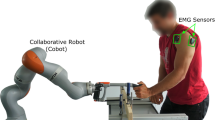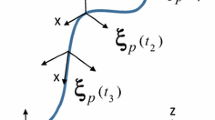Abstract
In this paper, we propose a novel method for human–robot collaboration, where the robot physical behaviour is adapted online to the human motor fatigue. The robot starts as a follower and imitates the human. As the collaborative task is performed under the human lead, the robot gradually learns the parameters and trajectories related to the task execution. In the meantime, the robot monitors the human fatigue during the task production. When a predefined level of fatigue is indicated, the robot uses the learnt skill to take over physically demanding aspects of the task and lets the human recover some of the strength. The human remains present to perform aspects of collaborative task that the robot cannot fully take over and maintains the overall supervision. The robot adaptation system is based on the Dynamical Movement Primitives, Locally Weighted Regression and Adaptive Frequency Oscillators. The estimation of the human motor fatigue is carried out using a proposed online model, which is based on the human muscle activity measured by the electromyography. We demonstrate the proposed approach with experiments on real-world co-manipulation tasks: material sawing and surface polishing.






Similar content being viewed by others
Notes
Note that this fatigue estimation procedure is subject-dependant. The subject was asked to endure the effort until task production became uncomfortable due to the muscle fatigue.
MVC calibration should be ideally performed every time the electrodes are reattached. However, the calibration of endurance time related parameter should theoretically be reusable if no drastic changes are made (e.g., muscle endurance may improve through physical training, etc.).
The value represents the mean and standard deviation of data from all subjects across the measured samples in the given stage of the experiment.
If required, the proposed human–robot interface could be extended to include voice command that can be used by the human to indicate to the robot to increase the stiffness in the y–z plane to maintain some desired position. However, the information flow rate of voice command is much lower compared to that of muscle activity interface (7) and could therefore be used only for auxiliary robot stiffness control.
References
Agravante, D., Cherubini, A., Bussy, A., Gergondet, P., & Kheddar, A. (2014). Collaborative human-humanoid carrying using vision and haptic sensing. In Robotics and Automation (ICRA), 2014 IEEE International Conferene on (pp. 607–612).
Ajoudani, A. (2016). Transferring human impedance regulation skills to robots. Berlin: Springer.
Ajoudani, A., Godfrey, S., Bianchi, M., Catalano, M., Grioli, G., Tsagarakis, N., et al. (2014). Exploring teleimpedance and tactile feedback for intuitive control of the pisa/iit softhand. IEEE Transactions on Haptics, 7(2), 203–215.
Albu-Schäffer, A., Haddadin, S., Ott, C., Stemmer, A., Wimböck, T., & Hirzinger, G. (2007). The DLR lightweight robot: Design and control concepts for robots in human environments. Industrial Robot: An International Journal, 34(5), 376–385.
Albu-Schäffer, A., Ott, C., Frese, U., & Hirzinger, G. (2003). Cartesian impedance control of redundant robots: recent results with the DLR-light-weight-arms. In Robotics and Automation (ICRA), 2003 IEEE International Conference on (vol. 3, pp. 3704–3709).
Ben Amor, H., Neumann, G., Kamthe, S., Kroemer, O., & Peters, J. (2014). Interaction primitives for human–robot cooperation tasks. In Robotics and Automation (ICRA), 2014 IEEE International Conference on (pp. 2831–2837).
Burdet, E., Osu, R., Franklin, D. W., Milner, T. E., & Kawato, M. (2001). The central nervous system stabilizes unstable dynamics by learning optimal impedance. Nature, 414(6862), 446–449.
De Luca, C. J. (1984). Myoelectrical manifestations of localized muscular fatigue in humans. Critical Reviews in Biomedical Engineering, 11(4), 251–279.
Ding, J., Wexler, A. S., & Binder-Macleod, S. A. (2000). A predictive model of fatigue in human skeletal muscles. Journal of Applied Physiology, 89(4), 1322–1332.
Donner, P., & Buss, M. (2016). Cooperative swinging of complex pendulum-like objects: Experimental evaluation. IEEE Transactions on Robotics, 32(3), 744–753.
Dragan, A. D., & Srinivasa, S. S. (2013). A policy-blending formalism for shared control. The International Journal of Robotics Research, 32(7), 790–805.
Enoka, R. M., & Duchateau, J. (2008). Muscle fatigue: What, why and how it influences muscle function. The Journal of physiology, 586(1), 11–23.
Evrard, P., Gribovskaya, E., Calinon, S., Billard, A., & Kheddar, A. (2009). Teaching physical collaborative tasks: Object-lifting case study with a humanoid. In IEEE-RAS International Conference on Humanoid Robots (pp. 399–404).
Fleischer, C., & Hommel, G. (2008). A human-exoskeleton interface utilizing electromyography. IEEE Transactions on Robotics, 24(4), 872–882.
Giat, Y., Mizrahi, J., & Levy, M. (1993). A musculotendon model of the fatigue profiles of paralyzed quadriceps muscle under fes. IEEE Transactions on Biomedical Engineering, 40(7), 664–674.
Gribovskaya, E., Kheddar, A., & Billard, A. (2011). Motion learning and adaptive impedance for robot control during physical interaction with humans. In Robotics and Automation (ICRA), 2011 IEEE International Conference on (pp. 4326–4332).
Hogan, N. (1984). Adaptive control of mechanical impedance by coactivation of antagonist muscles. IEEE Transactions on Automatic Control, 29(8), 681–690.
Ijspeert, A. J., Nakanishi, J., & Schaal, S. (2003). Learning attractor landscapes for learning motor primitives. In S. Becker, S. Thrun, & K. Obermayer (Eds.), Advances in neural information processing systems (pp. 1523–1530). Cambridge, MA: MIT Press.
Ikemoto, S., Ben Amor, H., Minato, T., Jung, B., & Ishiguro, H. (2012). Physical human–robot interaction: Mutual learning and adaptation. IEEE Robotics Automation Magazine, 19(4), 24–35.
Ikeura, R., & Inooka, H. (1995). Variable impedance control of a robot for cooperation with a human. In Robotics and Automation (ICRA), 1995 IEEE International Conference on (vol. 3, pp. 3097–3102).
Kaneko, K., Harada, K., Kanehiro, F., Miyamori, G., & Akachi, K. (2008). Humanoid robot HRP-3. In Intelligent Robots and Systems (IROS), 2008 IEEE/RSJ International Conference on (pp. 2471–2478).
Kosuge, K. & Kazamura, N. (1997). Control of a robot handling an object in cooperation with a human. In Robot and Human Communication, 6th IEEE International Workshop on (pp. 142–147).
Lee, D., & Ott, C. (2011). Incremental kinesthetic teaching of motion primitives using the motion refinement tube. Autonomous Robots, 31(2), 115–131.
Liu, J. Z., Brown, R. W., & Yue, G. H. (2002). A dynamical model of muscle activation, fatigue, and recovery. Biophysical Journal, 82(5), 2344–2359.
Ma, L., Chablat, D., Bennis, F., & Zhang, W. (2009). A new simple dynamic muscle fatigue model and its validation. International Journal of Industrial Ergonomics, 39(1), 211–220.
Ma, L., Chablat, D., Bennis, F., Zhang, W., & Guillaume, F. (2010). A new muscle fatigue and recovery model and its ergonomics application in human simulation. Virtual and Physical Prototyping, 5(3), 123–137.
Maeda, G. J., Neumann, G., Ewerton, M., Lioutikov, R., Kroemer, O., & Peters, J. (2017). Probabilistic movement primitives for coordination of multiple human–robot collaborative tasks. Autonomous Robots, 41(3), 593–612.
Medina, J., Shelley, M., Lee, D., Takano, W., & Hirche, S. (2012). Towards interactive physical robotic assistance: Parameterizing motion primitives through natural language. In RO-MAN, 2012 IEEE (pp. 1097–1102).
Nikolaidis, S., Kuznetsov, A., Hsu, D., & Srinivasa, S. (2016). Formalizing human–robot mutual adaptation: A bounded memory model. In 2016 11th ACM/IEEE International Conference on Human–Robot Interaction (HRI), (pp. 75–82).
Peternel, L., & Babič, J. (2013). Learning of compliant human–robot interaction using full-body haptic interface. Advanced Robotics, 27(13), 1003–1012.
Peternel, L., Noda, T., Petrič, T., Ude, A., Morimoto, J., & Babič, J. (2016a). Adaptive control of exoskeleton robots for periodic assistive behaviours based on EMG feedback minimisation. PLoS ONE, 11(2), e0148942.
Peternel, L., Oztop, E., & Babič, J. (2016b). A shared control method for online human-in-the-loop robot learning based on locally weighted regression. In 2016 IEEE/RSJ International Conference on Intelligent Robots and Systems (IROS), (pp. 3900–3906).
Peternel, L., Petrič, T., Oztop, E., & Babič, J. (2014). Teaching robots to cooperate with humans in dynamic manipulation tasks based on multi-modal human-in-the-loop approach. Autonomous Robots, 36(1–2), 123–136.
Peternel, L., Tsagarakis, N., & Ajoudani, A. (2017). A human-robot co-manipulation approach based on human sensorimotor information. IEEE Transactions on Neural Systems and Rehabilitation Engineering, 25(7), 811–822.
Peternel, L., Tsagarakis, N., Caldwell, D., & Ajoudani, A. (2016c). Adaptation of robot physical behaviour to human fatigue in human–robot co-manipulation. In IEEE-RAS International Conference on Humanoid Robots (pp. 489–494).
Petrič, T., Gams, A., Ijspeert, A. J., & Žlajpah, L. (2011). On-line frequency adaptation and movement imitation for rhythmic robotic tasks. The International Journal of Robotics Research, 30(14), 1775–1788.
Rozo, L., Bruno, D., Calinon, S., Caldwell, D. G. (2015). Learning optimal controllers in human–robot cooperative transportation tasks with position and force constraints. In Intelligent Robots and Systems (IROS), 2015 IEEE/RSJ International Conference on.
Sadrfaridpour, B., Saeidi, H., Burke, J., Madathil, K., & Wang, Y. (2016). Modeling and control of trust in human–robot collaborative manufacturing (pp. 115–141). Boston, MA.: Springer.
Schaal, S., & Atkeson, C. G. (1998). Constructive incremental learning from only local information. Neural Computation, 10(8), 2047–2084.
Tsagarakis, N., Caldwell, D. G., Bicchi, A., Negrello, F., Garabini, M., Choi, W., et al. (2017). WALK-MAN: A high performance humanoid platform for realistic environments. Journal of Field Robotics, 34(7), 1225–1259.
Tsumugiwa, T., Yokogawa, R., & Hara, K. (2002). Variable impedance control based on estimation of human arm stiffness for human–robot cooperative calligraphic task. In Robotics and Automation (ICRA), 2002 IEEE International Conference on (vol. 1, pp. 644–650).
Turvey, M. (2007). Action and perception at the level of synergies. Human Movement Science, 26(4), 657–697.
Author information
Authors and Affiliations
Corresponding author
Additional information
This is one of the several papers published in Autonomous Robots comprising the Special Issue on Learning for Human-Robot Collaboration.
This work was supported in part by the H2020 projects CogIMon (644727) and SOMA: Soft-bodied intelligence for Manipulation (645599).
Electronic supplementary material
Below is the link to the electronic supplementary material.
Supplementary material 1 (mp4 21007 KB)
Rights and permissions
About this article
Cite this article
Peternel, L., Tsagarakis, N., Caldwell, D. et al. Robot adaptation to human physical fatigue in human–robot co-manipulation. Auton Robot 42, 1011–1021 (2018). https://doi.org/10.1007/s10514-017-9678-1
Received:
Accepted:
Published:
Issue Date:
DOI: https://doi.org/10.1007/s10514-017-9678-1




